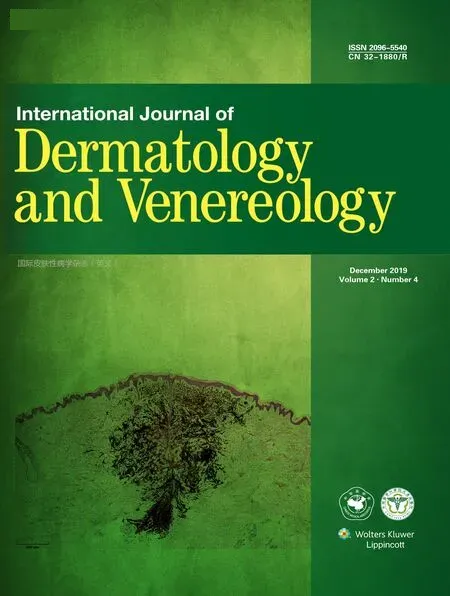Apocrine Sweat Gland Adenocarcinoma in the Left Retroauricular Area:A Rare Case Report
Xing Liu,An-Lan Hong,Zhang-Hui Yue,Chun Pan,Yan Wang,?,Xiu-Lian Xu,Fang FangDepartment of Dermatologic Surgery,Department of Pathology,Hospital for Skin Diseases(Institute of Dermatology),Chinese Academy of Medical Sciences and Peking Union Medical College,Nanjing 004,China.
Introduction
Primary apocrine sweat gland adenocarcinoma(PASGC)is a rare neoplasm,stemming from either normal or modified apocrine glands.We herein describe a rare case involving a woman of advanced age who developed PASGC in the left retroauricular area,where apocrine sweat gland has been rarely reported.
Case report
An 81-year-old woman without skin cancer history suddenly developed a left retroauricular soft,pink mass 2 years previously.The mass had slight exudation and a yellow scar on the surface,and it had rapidly increased in size fornearly past 1month.Itwasoriginallyasymptomatic,but it showed intermittent ulceration during the disease course.Systematic physical examination revealed no other lesions in the axillae or anogenital region,which contain many apocrine cells, and no enlarged or otherwise abnormal regional lymph nodes.The patient’s medical history included facial nerve paralysis.
Examination revealed a pink ridgy 3cm×4cm nodule with slight exudation and yellow scarring on the surface(Fig.1).Early and capsid antibodies to Epstein-Barr virus were negative, and all tumor markers were normal,including carcinoembryonic antigen,carbohydrate antigen 125,carbohydrate antigen 199,carbohydrate antigen 153,α-fetoprotein,neuron-specific enolase,and human chorionic gonadotropin.The visceral examination at the other hospital revealed no tumors.A fungal culture was negative.
The patient was referred to the Division of Dermatology to undergo a biopsy of the retroauricular area.A punch biopsy of the retroauricular skin lesion showed edema of the epidermal cells and a tumor located in the middle and lower parts of the dermis(Fig.2A).The tumor was composed of epithelioid cells, among which myxoid substances were present.The nuclei of the tumor cells were differently sized and uneven under low-power microscopy.Under further magnification,many cell nuclei were larger and more deeply stained.More importantly,nuclear atypia was found(Fig.2B).Immunohistochemically,the tumor cells were diffusely positive for CAM5.2,cytokeratin 7(CK7),CK,gross cystic disease fluid protein 15(GCDFP-15),p63,and S-100 protein(Fig.2C-2H).The tumor cells were negative for leukocyte common antigen,melan-A,and CK20.

Figure 1.Clinical appearance of the patient with primary apocrine sweat gland adenocarcinoma.A pink ridgy 3cm×4cm nodule with slight exudation and yellow scarring on the surface.
The patient was diagnosed with apocrine sweat gland adenocarcinoma.Because no other skin lesions or and visceral tumors were found,we diagnosed the patient as PASGC.
Discussion
PASGC is a rare neoplasm that presents as an isolated,asymptomatic, and mostly slow-growing lesion that originates from either normal or modified apocrine glands.1Although apocrine gland carcinoma(AGC)has also been reported in uncommon areas such as the forehead,wrist,ear,eyelid,trunk,foot,toe,and finger,2this carcinoma occurring in a retroauricular location is extremely rare.
Sweat gland carcinoma(SGC)is a rare tumor that is divided into the following types: AGC, malignant acrospiroma,malignant spiradenoma,malignant dermal cylindroma,malignant mixed tumor,sclerosing sweat duct(syringomatous) carcinoma, mucinous carcinoma, and adenoid cystic carcinoma.3However,several characteristics of SGC and AGC remain undefined and require further study,including the classification scheme,diagnostic criteria,prognostic features,and biologic markers.3

Figure 2.Histochemical results of biopsy from the patient with primary apocrine sweat gland adenocarcinoma.(A)Low-power view showed that the tumor was located in the middle and lower parts of the dermis(hematoxylin-eosin,×25).(B)High-power view revealed epithelioid cells and myxoid substances, uneven tumor cells, and some nuclei with deeper staining and atypia (hematoxylin-eosin, ×100).Immunohistochemistry of PASGC exhibited expression of(C)CAM5.2(×100),(D)CK7(×100),(E)CK(×100),(F)GCDFP-15(×100),(G)P63(×100),(H)S-100(×100).
SGC is traditionally divided into two groups:eccrine and apocrine. However, there is no definite classification between them,and many tumors have been found to have both eccrine and apocrine parts.1AGC is more likely to be positive for GCDFP-15,a marker that is positive in 84%of apocrine tumors.4
In this case,the immunohistochemistry examination revealed positive expression of GCDFP-15, and the pathological examination revealed large and small tumor cells with nuclei exhibiting deep staining and atypia.This disease was therefore diagnosed as AGC rather than benign adenoma.Moreover,no visceral tumors had emerged after the 1-year follow-up.PASGC has been found to be likely to progress aggressively with metastasis,so it is necessary to diagnose correctly and excise as early as possible,especially when the tumor is growing slowly.5Considering the scarcity of PASGC,lack of typical symptoms,lack of standards for diagnosis and classification,and indefiniteness of the location,differential diagnosis must be adequate and diagnosis must be accumulated.Furthermore,because few apocrine gland is found in the retroauricular area,it is possible that this tumor is derived from ectopic or modified apocrine gland.But it requires further and profound research.
Acknowledgements
This study was funded by the National Natural Science Fund of China(No.81872216)and PUMC Postgraduate Education and Teaching Reform Project in 2018(No.10023201801701).
- 國際皮膚性病學(xué)雜志的其它文章
- Instructions for Authors
- Deep Penetrating Nevus
- Actinic Granuloma:A Case Report
- Cutaneous Metastasis of Uterine Cervical Carcinoma with a Cellulitis-Like Presentation
- Squamous Cell Carcinoma Secondary to Mutilating Palmoplantar Keratoderma
- Toxic Shock Syndrome Due to Streptococcus pyogenes Presenting with Purpura Fulminans in an Older Adult

